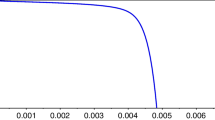Abstract
Using the linear matrix inequality technique, in this paper we construct a convex estimate of the attraction domain for a linear system with L 2-bounded control in the form of linear static state feedback. A robust statement of the problem is also studied, when the control system contains structured matrix uncertainty. The results of numerical simulations are presented.
Similar content being viewed by others
References
Boyd, S., El Ghaoui, L., Feron, E., and Balakrishnan, V., Linear Matrix Inequalities in System and Control Theory, Philadelphia: SIAM, 1994.
Khlebnikov, M.V. and Shcherbakov, P.S., Optimal Feedback Design under Bounded Control, Autom. Remote Control, 2014, vol. 75, no. 2, pp. 320–332.
Balandin, D.V. and Kogan, M.M., Sintez zakonov upravleniya na osnove lineinykh matrichnykh neravenstv (LMI-based Control System Design), Moscow: Fizmatlit, 2007.
Khlebnikov, M.V., Polyak, B.T., and Kuntsevich, V.M., Optimization of Linear Systems Subject to Bounded Exogenous Disturbances: The Invariant Ellipsoid Technique, Autom. Remote Control, 2011, vol. 72, no. 11, pp. 2227–2275.
Bašar, T. and Bernhard, P., H ∞-Optimal Control and Related Minimax Design Problems: A Dynamic Game Approach, Boston: Birkhäuser, 1995.
Doyle, J.C., Glover, K., Khargonekar, P.P., and Francis, B.A., State-Space Solution to Standard H 2 and H ∞ Control Problem, IEEE Trans. Automat. Control, 1989, vol. 34, no. 8, pp. 831–847.
Zhou, K., Doyle, J., and Glover, K., Robust and Optimal Control, New Jersey: Prentice Hall, 1996.
Balandin, D.V. and Kogan, M.M., Lyapunov Function Method for Control Law Synthesis under One Integral and Several Phase Constraints, Differ. Uravn., 2009, vol. 45, no. 5, pp. 670–679.
Balandin, D.V. and Kogan, M.M., Generalized H ∞-Optimal Control as a Trade-off Between the H ∞-Optimal and γ-Optimal Controls, Autom. Remote Control, 2010, vol. 71, no. 6, pp. 993–1010
Polyak, B.T. and Shcherbakov, P.S., Robastnaya ustoichivost’ i upravlenie (Robust Stability and Control), Moscow: Nauka, 2002.
Khlebnikov, M.V. and Shcherbakov, P.S., Petersen’s Lemma on Matrix Uncertainty and Its Generalization, Autom. Remote Control, 2008, vol. 69, no. 11, pp. 1932–1945.
Golub, G.H. and Van Loan, C.F., Matrix Computations, Baltimore: The John Hopkins Univ. Press, 1983. Translated under the title Matrichnye vychisleniya, Moscow: Mir, 1999.
Grant, M. and Boyd, S., CVX: Matlab Software for Disciplined Convex Programming, URL http://stanford.edu/boyd/cvx.
Author information
Authors and Affiliations
Corresponding author
Additional information
Original Russian Text © M.V. Khlebnikov, 2015, published in Avtomatika i Telemekhanika, 2015, No. 3, pp. 3–12.
Rights and permissions
About this article
Cite this article
Khlebnikov, M.V. Estimates of the attraction domain of linear systems under L 2-bounded control. Autom Remote Control 76, 369–376 (2015). https://doi.org/10.1134/S0005117915030017
Received:
Published:
Issue Date:
DOI: https://doi.org/10.1134/S0005117915030017



